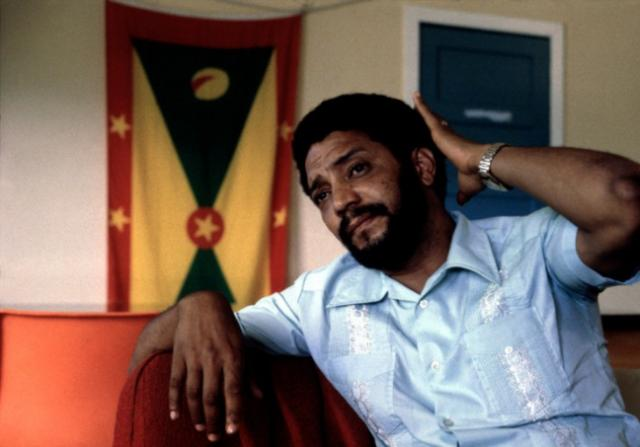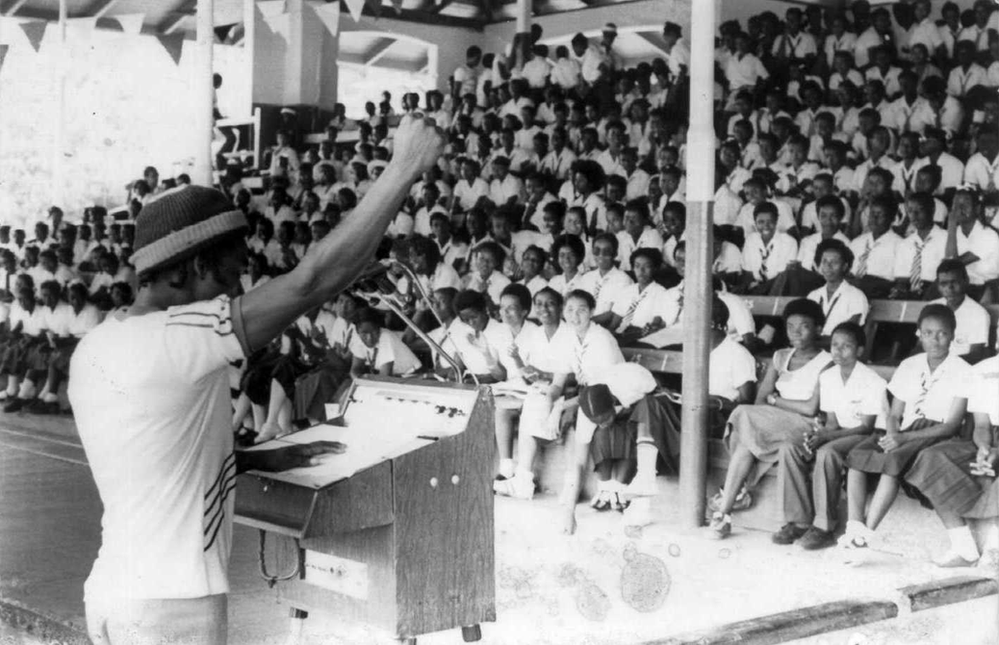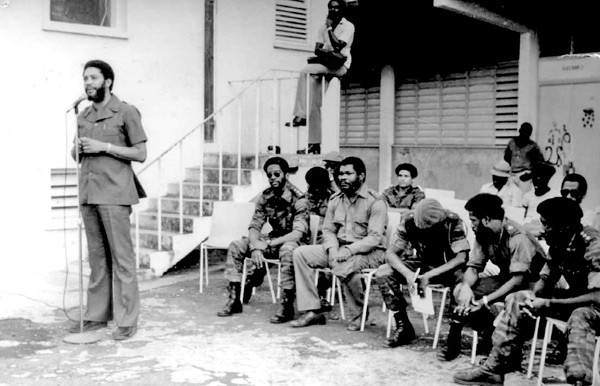The Grenada Revolution was seen as the doorway into a future rid of the subjugation, oppression, and backwardness of the past. It was a chance to grow and blossom into a nation free to choose. Maurice Bishop became the driving force who heralded the revolution, determined to chart a progressive way forward.
Maurice Bishop, a charismatic young lawyer, was the most prominent leader of the revolution. Born in Aruba on May 29, 1944 to Grenadian parents, he migrated to Grenada with his family in 1950. He received his law degree from the University of London. In 1973, he formed the political group Movement for Assemblies of the People (MAP) and then merged with another political group led by his colleague known as the Joint Action For Education Welfare & Liberation (JEWEL). The organization resulting from the merger was called the New Jewel Movement (NJM). That same year, Bishop was elected to the House of Representatives and was appointed the Leader of the Opposition. He held that position for three years until March 13, 1979 when Bishop and his followers seized control over the government in a bloodless coup while Prime Minister Eric Gairy was out of the country. Gairy had a record of repression, personal enrichment, neocolonial policy, and alignment with the most reactionary states in the region had lost him the trust and respect of the people.

The coup was widely popular with Grenadians and it seemed as though the entire island had come out to the streets to celebrate. “The Grenada Revolution was a grasp of joy … that life unfulfilled could and would change, be transformed for a people who had known 400 years of transportation, slavery, colonialism, neocolonial dictatorship and exportation to the cities of Europe and North America,” English popular educator and internationalist Chris Searle told Grenada Morning. “Joy that the organized genius of ordinary people could at last be applied to develop their own resources for their own future. There was the joy of education, of seeing your children achieving free secondary schooling, and your illiterate mother learning how to read and write, the joy of seeing wasted, unemployed youths forming cooperatives and planting the idle land.” The excitement of the revolution was felt all around the Caribbean as well as in the Caribbean communities in the US and Canada. Grenada immediately became a center of attraction for socialists, anti-imperialists, and Black Power activists. Major figures from the US such as Angela Davis and Harry Belafonte visited Grenada and were deeply inspired. Progressive policies, educators, activists, and writers from throughout the region came to work in Grenada. This peaceful revolution in a small Caribbean country was a landmark moment with effects that rippled throughout the world.

(Photo: Invent the Future)
Bishop proclaimed a People’s Revolutionary Government and suspended the constitution. He promised new democratic and became the new Prime Minister. Bishop and the NJM envisioned a Grenada that operated on participatory and popular democracy, based on inclusion and fairness. He modeled his ideas on those of Tanzanian Pan Africanist Julius Nyerere whose conceptualization of ujamaa, family hood, cooperative economics, informed social, political, and economic frameworks in Tanzania. Bishop sought out a new framework that would correct the inequities brought by slavery, colonialism, and post colonialism.
The NJM favored a collective approach to dealing with a range of social, political, and economic problems in Grenada. This was the antithesis to Gairy’s policies. It developed a program to improve housing, education, public health, food and recreation. NJM also published a newspaper, The New Jewel, which quickly became the most widely circulated newspaper on the island. From its inception, NJM opposed Gairy’s plans for independence, which led to a strike on November 1, 1973. A People’s Congress was convened, which tried Gairy and found him guilty of crimes against the peoples. Protests continued into 1974 against the Gairy government. The party announced another general strike, but on the day of the strike NJM leaders were severely beaten. In a separate protest, powerful interests killed Rupert Bishop, Maurice’s father, who was peacefully protesting,
The Grenadian Revolution accomplished important progress in all areas of the state. Employers were now mandated to recognize unions and workers’ right to strike. The society was reorganized along collectivist lines, and councils were established in workplaces, parishes, villages, and neighborhoods. Women were also central to the revolution and NJM established a Women’s Desk in the Ministry of Education and Social Affairs, which supported maternity leave and equal pay. There was also growth in the agricultural and educational sectors. Land reform initiatives allowed low-interest loans to farmers and cooperatives as well as programs to create markets for produce. Educational programs brought literacy rates to 89 percent and elementary children received free books, school uniforms, and hot lunches.

Photo: Maurice Bishop speaks
Infrastructure also greatly improved and a new international airport, promoting trade and tourism, was built with the assistance of Cuba. Investments in manufacturing brought new factories that processed, packaged, and marketed products. However, the West saw Grenada as a proxy state for the Soviets and was heavily influenced by Cuba. This belief overshadowed many of the Bishop government’s accomplishments. Western leaders viewed the new Port Saline’s Airport as proof of association between Grenada and the Soviet Union; it was another attempt of the Soviets to exert influence in the Western Hemisphere. Furthermore, Grenada was the first English-speaking country in the Americas to have undergone a successful revolution of the oppressed, and still remains the only one to do so. In addition, it was a revolution led by the descendants of African slaves, and was seen as a particularly dangerous example to the Black population of North America. In turn, the U.S. immediately made plans to undermine Grenada’s government. They mobilized elements within the trade union movement to call strikes when the government was unable to meet demands for enormous wage increases. There were boss-led lockouts, production was sabotaged, and rallies were bombed. A wide-ranging campaign was conducted in the ‘free’ (rich-white owned) Caribbean press against the Grenadian revolution.
Internal dissension within the NJM which led to a dispute between Bishop and his Deputy Prime Minister Bernard Coard, who wanted Bishop to engage in a power-sharing agreement. Bishop refused and was placed under house arrest, though his popularity led to his release. Bishop, his supporters, and members of his government proceeded to the army headquarters at Fort Rupert, where fighting began and assassins lined up Bishop and several of his government ministers and shot them. Following Bishop’s assassination in 1983, a military government led by Hudson Austin was established. The chaos and confusion surrounding the events set the stage for broader international actions. Within six days, the United States invaded Grenada and overthrew the government.
Bishop’s life exemplified courage and dedication to complete societal transformation and has been lauded around the world. His interest in nonaligned nations made him a thought leader in the limitations of Western interests during the Cold War. In the struggle for liberation, his willingness to sacrifice himself and did indeed sacrifice his life for the freedom of African-descended people.
Powered by WPeMatico


